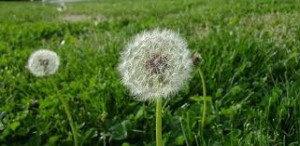Regular Maintenance Goes a Long Way
Dandelions, chickweed, ground ivy, henbit, knotweed, plantain, and thistle… all sorts of  broadleaf weeds will soon be making an appearance. It would be great if we could eliminate these pests once and for all. The thing is, they create a lot of seeds, so complete elimination isn’t possible.
broadleaf weeds will soon be making an appearance. It would be great if we could eliminate these pests once and for all. The thing is, they create a lot of seeds, so complete elimination isn’t possible.
Just one dandelion seed head can hold over 200 seeds, which are capable of traveling very long distances by wind, water, on animals and on the bottom of our shoes. New weed seeds are constantly finding their way into the soil on your property, and they can remain in the soil for years until they get enough sun and water to germinate.
GOOD LAWN CARE PRACTICES CROWD OUT WEEDS
Proper lawn maintenance encourages thicker, healthier grass, and that’s the best way to prevent broadleaf weeds. The denser your lawn, the less room these weeds will have to grow. Three keys to crowding out broadleaf weeds are:
- Mowing: Removing no more than 1/3 of the grass blade each time you mow. This keeps the soil shaded to discourage germination of weed seeds.
- Watering: Making sure your lawn gets from 1” to 1 ½” of water per week from rainfall or sprinkling.
- Fertilizing: Fertilizing regularly to expand your lawn’s root system for more vigorous growth.
 POST- EMERGENT HERBICIDES CAN HELP TOO
POST- EMERGENT HERBICIDES CAN HELP TOO
Whenever broadleaf weeds pop up, they can be spot treated with a post- emergent herbicide. Keep in mind that it can take up to three weeks for treated weeds to die off, and repeat applications may be necessary if new weeds appear throughout the season. Also, if your lawn has been seeded, post-emergent herbicides shouldn’t be used until the new grass has been mowed at least three times.
Yes, broadleaf weeds are a nuisance, but they can be managed. With the right lawn care practices, post-emergent herbicides and a little patience, they won’t have nearly as much of an impact on your lawn.


